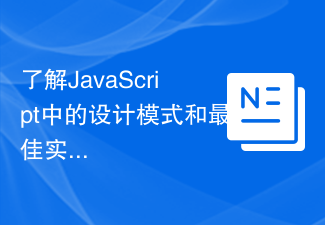Design patterns in Java framework are used to enhance the scalability, maintainability and reusability of code. Commonly used patterns include: Singleton Pattern: Ensures that only one instance of a class exists and accesses it throughout the application. Factory method pattern: Create an interface for objects, and the subclass decides which object to instantiate. Observer pattern: Define a one-to-many dependency relationship. When one object changes, other objects receive notifications and update their status. Strategy pattern: Define a series of algorithms and make them interchangeable, making the algorithm class independent of the client class.

Commonly used design patterns in Java frameworks
In the software development process, design patterns are a proven code organization Structures for solving common problems. In Java frameworks, design patterns are widely used to enhance the scalability, maintainability, and reusability of code. The following are some of the most commonly used design patterns in Java frameworks:
Singleton pattern
-
Purpose: Ensure a Only one instance of a class exists, and that instance is accessed throughout the application.
public class Singleton { private static Singleton instance; private Singleton() { /* Private constructor to prevent instantiation */ } public static Singleton getInstance() { if (instance == null) { instance = new Singleton(); } return instance; } }
Factory method pattern
##Purpose: Define an interface for creating objects, let The subclass determines which class is instantiated.
public interface ShapeFactory { Shape createShape(); } public class CircleFactory implements ShapeFactory { @Override public Shape createShape() { return new Circle(); } } public class SquareFactory implements ShapeFactory { @Override public Shape createShape() { return new Square(); } }
Observer Pattern
- ##Purpose:
Define one-to-many between objects Dependencies, when one object changes, other objects are notified and update their state.
public interface Observer { void update(Subject subject); } public class Subject { private List<Observer> observers = new ArrayList<>(); public void addObserver(Observer observer) { observers.add(observer); } public void removeObserver(Observer observer) { observers.remove(observer); } public void notifyObservers() { for (Observer observer : observers) { observer.update(this); } } }
- ##Purpose:
- Define a series of algorithms, encapsulate them and make them They are interchangeable. This pattern makes algorithm classes independent of the client classes that use them.
public interface Strategy { int calculate(int num1, int num2); } public class AdditionStrategy implements Strategy { @Override public int calculate(int num1, int num2) { return num1 + num2; } } public class SubtractionStrategy implements Strategy { @Override public int calculate(int num1, int num2) { return num1 - num2; } }Practical case: Observer pattern in Spring Framework
Spring Framework uses the observer pattern to notify bean events. When a bean is created, destroyed, or changed, Spring publishes events that applications can subscribe to and act accordingly.
@EventListener(ApplicationReadyEvent.class)
public void handleApplicationReadyEvent() {
// 在应用程序启动时执行的操作
}The above is the detailed content of Common design patterns in Java frameworks. For more information, please follow other related articles on the PHP Chinese website!
 如何在PHP后端功能开发中合理应用设计模式?Aug 07, 2023 am 10:34 AM
如何在PHP后端功能开发中合理应用设计模式?Aug 07, 2023 am 10:34 AM如何在PHP后端功能开发中合理应用设计模式?设计模式是一种经过实践证明的解决特定问题的方案模板,可以用于构建可复用的代码,在开发过程中提高可维护性和可扩展性。在PHP后端功能开发中,合理应用设计模式可以帮助我们更好地组织和管理代码,提高代码质量和开发效率。本文将介绍常用的设计模式,并给出相应的PHP代码示例。单例模式(Singleton)单例模式适用于需要保
 如何通过编写代码来学习和运用 PHP8 的设计模式Sep 12, 2023 pm 02:42 PM
如何通过编写代码来学习和运用 PHP8 的设计模式Sep 12, 2023 pm 02:42 PM如何通过编写代码来学习和运用PHP8的设计模式设计模式是软件开发中常用的解决问题的方法论,它可以提高代码的可扩展性、可维护性和重用性。而PHP8作为最新版的PHP语言,也引入了许多新特性和改进,提供更多的工具和功能来支持设计模式的实现。本文将介绍一些常见的设计模式,并通过编写代码来演示在PHP8中如何运用这些设计模式。让我们开始吧!一、单例模式(Sing
 深入聊聊设计模式利器之“职责链模式”(附go实现流程)Jan 17, 2023 am 11:43 AM
深入聊聊设计模式利器之“职责链模式”(附go实现流程)Jan 17, 2023 am 11:43 AM本篇文章给大家带来了关于golang设计模式的相关知识,其中主要介绍了职责链模式是什么及其作用价值,还有职责链Go代码的具体实现方法,下面一起来看一下,希望对需要的朋友有所帮助。
 Go语言中的ETL的设计模式Jun 01, 2023 pm 09:01 PM
Go语言中的ETL的设计模式Jun 01, 2023 pm 09:01 PM随着数据的增长和复杂性的不断提升,ETL(Extract、Transform、Load)已成为数据处理中的重要环节。而Go语言作为一门高效、轻量的编程语言,越来越受到人们的热捧。本文将介绍Go语言中常用的ETL设计模式,以帮助读者更好地进行数据处理。一、Extractor设计模式Extractor是指从源数据中提取数据的组件,常见的有文件读取、数据库读取、A
 深入解析Go语言中的单例模式Mar 21, 2023 pm 06:36 PM
深入解析Go语言中的单例模式Mar 21, 2023 pm 06:36 PM单例模式是一种常见的设计模式,它在系统中仅允许创建一个实例来控制对某些资源的访问。在 Go 语言中,实现单例模式有多种方式,本篇文章将带你深入掌握 Go 语言中的单例模式实现。
 了解JavaScript中的设计模式和最佳实践Nov 03, 2023 am 08:58 AM
了解JavaScript中的设计模式和最佳实践Nov 03, 2023 am 08:58 AM随着JavaScript的不断发展和应用范围的扩大,越来越多的开发人员开始意识到设计模式和最佳实践的重要性。设计模式是一种被证明在某些情况下有用的软件设计解决方案。而最佳实践则是指在编程过程中,我们可以应用的一些最佳的规范和方法。在本文中,我们将探讨JavaScript中的设计模式和最佳实践,并提供一些具体的代码示例。让我们开始吧!一、JavaScript中
 设计模式的六大原则是什么Jan 06, 2023 pm 04:25 PM
设计模式的六大原则是什么Jan 06, 2023 pm 04:25 PM设计模式的六大原则:1、单一职责原则,其核心就是控制类的粒度大小、将对象解耦、提高其内聚性;2、开闭原则,可以通过“抽象约束、封装变化”来实现;3、里氏替换原则,主要阐述了有关继承的一些原则;4、依赖倒置原则,降低了客户与实现模块之间的耦合;5、接口隔离原则,是为了约束接口、降低类对接口的依赖性;6、迪米特法则,要求限制软件实体之间通信的宽度和深度。
 C#开发建议:设计模式与架构选择Nov 22, 2023 pm 03:53 PM
C#开发建议:设计模式与架构选择Nov 22, 2023 pm 03:53 PM在C#开发中,设计模式和架构选择是至关重要的。良好的设计模式和合适的架构选择可以大大提高软件的可维护性、扩展性和性能。本文将讨论一些在C#开发中常用的设计模式和架构选择,并给出一些建议。设计模式是解决特定问题的通用解决方案,它们可以帮助开发人员避免重复造轮子,提高代码的可重用性和可读性。在C#开发中,有许多常用的设计模式,如单例模式、工厂模式、观察者模式等。


Hot AI Tools

Undresser.AI Undress
AI-powered app for creating realistic nude photos

AI Clothes Remover
Online AI tool for removing clothes from photos.

Undress AI Tool
Undress images for free

Clothoff.io
AI clothes remover

AI Hentai Generator
Generate AI Hentai for free.

Hot Article

Hot Tools

SublimeText3 Chinese version
Chinese version, very easy to use

Dreamweaver Mac version
Visual web development tools

WebStorm Mac version
Useful JavaScript development tools

Notepad++7.3.1
Easy-to-use and free code editor

SecLists
SecLists is the ultimate security tester's companion. It is a collection of various types of lists that are frequently used during security assessments, all in one place. SecLists helps make security testing more efficient and productive by conveniently providing all the lists a security tester might need. List types include usernames, passwords, URLs, fuzzing payloads, sensitive data patterns, web shells, and more. The tester can simply pull this repository onto a new test machine and he will have access to every type of list he needs.






